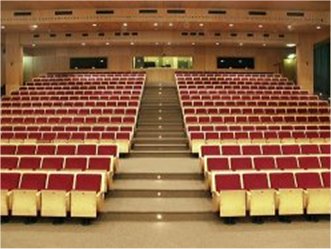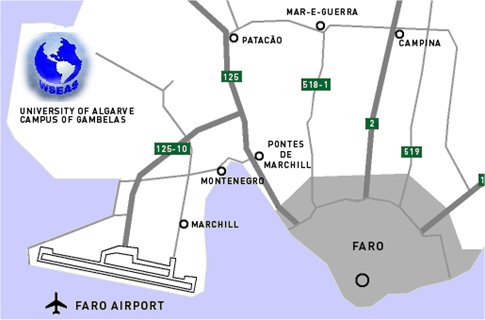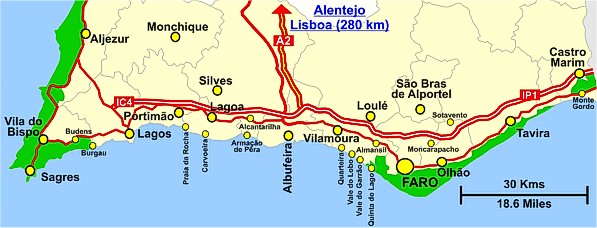|
LOCATION:

Faro is a
city and municipality in southern Portugal. The city
proper has 41,934 inhabitants and the entire
municipality has 58,305. It is the seat of the district
of Faro and capital of the Algarve region. The Algarve
and Faro district cover the same territory.
The Ria Formosa lagoon attracted human occupants from
the Palaeolithic age until the end of pre-history.
During that time a settlement grew up – Ossonoba – which
was an important town during the period of Roman
occupation and, according to historians, the forerunner
of present-day Faro. From the 3rd century onwards and
during the Visigothic period it was the site of an
Episcopal see.
With the advent of Moorish rule in the 8th century
Ossonoba retained its status as the most important town
in the southwest corner of the Iberian Peninsula. In the
9th century it became the capital of a short-lived
princedom and was fortified with a ring of defensive
walls. At this time the name Santa Maria began to be
used instead of Ossonoba. Later on the town was known as
Harun (from a local Muslim chieftain), whence its
current name, Faro. During the 500 years of Moorish rule
there were some Jewish inhabitants in Faro who wrote
copies of the Old Testament. After the Moorish period,
the Moors were defeated by the forces of the Portuguese
King Afonso III in 1272. With the decline of the
importance of the city of Silves, Faro took over the
role of administration of the Algarve area.

The Earl of Essex sacked the town in 1596 and seized the
library of the Bishop of Faro. These books were later
donated to the University of Oxford, becoming part of
the Bodleian Library.
Lagos had become the capital of the historical province
of Algarve in 1577 and remained so until 1756, the year
following the destruction of much of the town by the
1755 Lisbon earthquake. The earthquake damaged several
areas in the Algarve, where a tsunami dismantled some
coastal fortresses and, in the lower levels, razed
houses. Almost all the coastal towns and villages of the
Algarve were heavily damaged, except Faro, which was
protected by the sandy banks of Ria Formosa lagoon.
Since then Faro has been the administrative seat of the
region.
The city has a public university (the University of the
Algarve), an international airport (Faro airport), a
seaport, a marina, a railroad station and complete
interregional bus services.

Its 30,000-seater stadium Estadio Algarve, shared by the
neighboring cities of Faro and Loule, was one of the
venues of the Euro 2004. It currently stands vacant, but
locals hope that a football team will finally give use
to the Stadium. The actual relevance of Louletano
Desportos Clube (a club from the city of Loule) and
Sporting Clube Farense (from Faro), are not enough to
use such a big stadium; instead they use smaller
municipal stadiums. The stadium is also used to host
concerts, festivals and other events.
Faro airport is not too far away from the city itself.
In recent years the numbers of visitors travelling
through the airport has increased as more and more
low-cost airlines compete to offer cheap flights to the
Algarve. The transport facilities to and from Faro
airport with the centre of Faro include taxicabs and a
bus line.
Additional links
about Faro and Portugal
http://www.rtalgarve.pt
Virtual Portugal
World Travel Guide
Portugal Info
Academic
Links
Universities via Yahoo.com - Universities.
U.S. Higher Education - usefull links to U.S.
universities
How to get to Faro
The conference will be held at the Auditorium of the
University of Algarve,
Campus de Gambelas, in Faro.

Faro is located 280 km south of Lisbon and is connected
by high-way to Lisbon and Seville (200 Km). Faro can
also be reached by railway and plane.
Faro international Airport is served by several major
airlines. The distance between the Faro International
Airport and the city of Faro is about 5 Km. To get to
the city a taxi will cost you from 8 to 10 €.

The city of Faro is the provincial capital of the
Algarve region located in the south end of Portugal,
with a population of 60.000.
If coming from Lisbon (Lisbon International Airport),
trains and buses will take from 3 to 4 hours to reach
your destiny. Both Faro train station and Faro bus
station are located at the city centre.
Trains ("Alfa-Pendular" or "Inter-cidades" are fastest
trains)
Buses
 |





